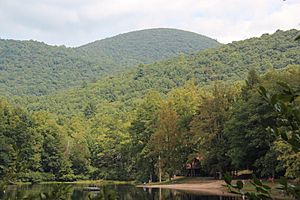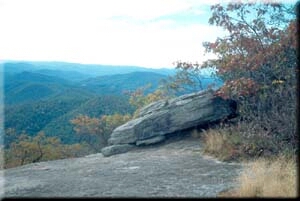Lake Winfield Scott facts for kids
Quick facts for kids Lake Winfield Scott |
|
|---|---|

A view of Lake Winfield Scott's shoreline
|
|
| Location | Union County, Georgia, United States |
| Coordinates | 34°44′26″N 83°58′33″W / 34.7406°N 83.9757°W |
| Lake type | reservoir |
| Primary outflows | Cooper Creek |
| Basin countries | United States |
| Surface area | 18 acres (7.3 ha) |
| Surface elevation | 2,854 ft (870 m) |
Lake Winfield Scott is a beautiful mountain lake in Union County, Georgia. It covers about 18-acre (7.3 ha) and is located 10 miles (16 km) south of Blairsville. This lake is special because it's one of Georgia's highest lakes, sitting at 2,854 feet (870 m) above sea level.
The U.S. Forest Service owns and takes care of Lake Winfield Scott. It's the starting point for Cooper Creek. The lake is also the main attraction of the Lake Winfield Scott Recreation Area. This park is a great place for outdoor fun like hiking, fishing, and boating. The area around the lake is home to many different plants and animals.
Contents
History of Lake Winfield Scott
Lake Winfield Scott is a man-made lake, also known as a reservoir. It was finished in early 1942. The lake was built by the Civilian Conservation Corps (CCC). The CCC was a program that helped young men find jobs during the Great Depression. They worked on projects like building parks and improving natural areas.
Building Lake Winfield Scott was one of the last projects the CCC completed in Georgia. It was finished just after the United States joined World War II. The lake is located in the southern part of the Blue Ridge Mountains, close to Blood Mountain.
The lake was named after Winfield Scott, a famous American General. He lived in the 1800s and was also a diplomat and once ran for president. People called him "Old Fuss and Feathers." He was a hero in the Mexican–American War. He was also the first American since George Washington to hold the high rank of lieutenant general.
Long ago, the Cherokee and Creek Native American tribes lived in this area. They sometimes fought over resources. A battle happened near Slaughter Gap. The Creek lost, and the Cherokee gained control of the Blood Mountain area. The Cherokee believed this place was very special and holy. Scientists have found clues that suggest this battle really happened.
In 1838, General Winfield Scott was involved in moving Native American tribes from this area. They were forced to move west on what is known as the "Trail of Tears". Later, farmers moved in. By the 1880s, companies started cutting down trees in the forests.
Lake Winfield Scott first opened to the public on May 14, 1938. This was part of the Forest Service's plan to use the Chattahoochee-Oconee National Forest for everyone's benefit. In the 1990s, the U.S. Army Corps of Engineers made the lake's dam stronger.
Location and Natural Surroundings

Lake Winfield Scott is easy to find. It's about 4.5 miles east of Suches on Highway 180. It's also 7.1 miles west of U.S. Highway 19/129, close to Vogel State Park. There are two ways to enter the park. The north entrance is just for getting to the lake. The south entrance leads to the camping areas, hiking trails, and lake activities.
The forests around the lake are full of hardwood trees. In the fall, these trees turn bright colors. This makes the area a very popular place to visit during the "leaf season."
Amazing Animals and Plants
The area around Lake Winfield Scott is part of the southern Blue Ridge Mountains. This region has many valleys, ridges, and mountains. They were formed over billions of years by Earth's plates moving and crashing together. This created a landscape with many different kinds of plants and animals. The climate and wildlife here are similar to what you might find in Pennsylvania.
Some special trees like Eastern hemlock and Eastern white pine grow here. These are near their southernmost limit. The forests have rich plant life, including rare wildflowers and ferns. You might see Painted Trillium growing near Rhododendron. Other unique plants like Dutchman's breeches and Squirrel corn grow in rocky areas.
Many animals live around the lake. You can find white tail deer, grouse, and raccoons. The deer population almost disappeared by 1895. But a park ranger named Arthur Woody brought them back in the 1930s.
Over 100 types of birds live in or visit this area. These include songbirds like the Canada, Blackburnian, and Black-throated Blue warblers. You might also spot hawks, owls, woodpeckers, and many other birds. Birdwatchers love this area, especially in late spring and early fall when birds are migrating. The creeks around the lake are also home to many different kinds of salamanders.
Fun Activities at Lake Winfield Scott
The recreation area around the lake offers many fun things to do. You can go camping, have a picnic, boat, fish, and hike on various trails. Motorcyclists also like this area. They call it the start of "The Georgia Triangle," which is a beautiful route for riding.
Fishing, Boating, and Swimming Fun
Lake Winfield Scott is a favorite spot for fishing. The lake is regularly stocked with rainbow trout. You can also catch local warmwater fish like largemouth bass and sunfish.
The lake has a boat ramp and a boat dock. There's also a swimming area with a sandy beach. The Forest Service only allows boats powered by people (like canoes or kayaks) or electric motors.
Camping and Hiking Adventures

The camping area has 36 campsites. Twenty-one of these sites can fit both tents and RVs, and they have utility hook-ups. There's also a special group camping area for up to 25 people. The park has clean restrooms with flush toilets and showers. You can even rent a cabin for your stay.
The recreation area also has a playground for kids and picnic spots. The campground is open from spring through fall. It's managed by the U.S. Forest Service.
There are three main hiking trails at the lake:
- The Lake Winfield Scott Trail is an easy 0.4-mile (640 m) loop around the lake. Parts of this trail are even accessible for wheelchairs.
- The Jarrard Gap Trail and Slaughter Gap Trail both start at the southern end of the lake. These trails lead to the famous Appalachian Trail. They are marked with blue blazes.
The Slaughter Creek Trail is about 2.7-mile (4.3 km) long. It goes through a hardwood forest along Slaughter Creek. This trail climbs about 1,000 feet (300 m) to Slaughter Gap. At Slaughter Gap, it meets the Appalachian Trail at the base of Blood Mountain. Along the way, you'll see thick bushes of mountain laurel and rosebay rhododendron. You'll also cross the creek. In the spring, this trail is full of beautiful wildflowers. From Slaughter Gap, it's another 1.4 miles (2.3 km) along the Appalachian Trail to the top of Blood Mountain.
The Jarrard Creek Trail is an easy to moderate hike. It goes south for 1.2 miles (1.9 km) to Jarrard Gap. This gap is at an elevation of 3,300 feet (1,000 m) and is also on the Appalachian Trail. The trail follows Lances Branch creek through forests. You can combine Jarrard Creek Trail with Slaughter Creek Trail and a part of the Appalachian Trail to make a six-mile loop hike that starts and ends at the lake.



